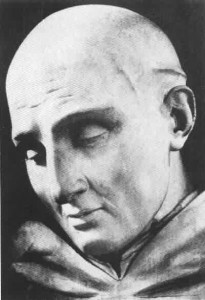Skip to content
St. Brunos, priest monk, founder of the Carthusian order..
Holiday: Oktober 6
* around 1031 Köln, North Rhine-Westphalia, Germany
† 6 October 1101 Monastery of Santa Maria dell’s emo, Tal La Torre near today’s Serra San Bruno, Italy
Meaning of the name: brown (German)
Attributes: book, skull, cross, seven stars – as a symbol of Carthusian silence
Patron of the possessed; against the sea

St. Bruno
St. Bruno was born around 1035 into the religious noble Hartenfaust family in Cologne. Even as a boy, he made an unusual impression – he was not interested in children’s games, he did not play with other children. From an early age, he was very religious, kind, and behaved well. He studied in his hometown, later in Reims and in Tours, where he attended philosophy under the guidance of the teacher Berengár. He was very diligent There’s no text between the quotes. and acquired deep and thorough knowledge. He obtained a doctorate in theology. In 1057, the Reims archbishop Gervaz entrusted him with the administration of the school where Bruno previously studied. The archbishop Additionally, he was granted a canon at the Temple and later appointed administrator of the archbishop. Consistory. He remained the administrator of the school until 1075. Many students not only graduated during his tenure but also improved in Christian virtues. After the death of the archbishop, thanks to the bribery of the royal advisers, Manassas, who lived a scandalous life, became bishop. When Bruno – as the only brave one – reprimanded him for his immorality, Manassas deprived him of his office and all income. Since Bruno had already thought about withdrawing into solitude, it came in handy. Although two years later the unworthy archbishop was deposed and Bruno was called back, he did not return. They went to Grenoble with their six friends. The local bishop, St. Hugo, who was his pupil, kindly received them and, at Bruno’s request, provided them with a barren, inaccessible plot of land in the Chartreuse hills (Cartusia in Latin). It was about 24 km north of Grenoble. He also gave them the use of the surrounding forests. The companions built a chapel there and around it lonely hermitages – hermitages, and lived according to the way of former hermits in Egypt and the Holy Land. In the morning and the afternoon, they gathered in the chapel for services. After the prayers, they went to work. They never ate meat. During fasting, they ate only once a day. Everyone prepared the food themselves. Their clothing was coarse and rough. Once a week, they didn’t talk at all. The woman did not have access to their premises. Although they lived such an austere and ascetic life, many young men came and begged to be accepted. Bishop Hugo liked to visit them and would prefer to settle there permanently. However, Bruno, as superior, made sure that no one overdoes it with acts of self-denial.
Six years have passed. Bruno and his companions transformed a wild wasteland into a beautiful, flourishing place. In 1088, Urban II, real name Odo de Chatillon, a former pupil of Bruno, became Pope. He called Bruno to Rome to help him administrate the Church. Bruno left his beloved solitude with a heavy heart, but the following year, out of obedience, he set out on a journey with several brothers. The Pope accommodated the monks in his palace. However, they did not get used to the noisy city. The brothers returned to Carthage. Bruno was left alone and felt that he lacked solitude. At that time, the Pope had to escape from Rome before Emperor Henry IV and Antipope Clement. That’s when Bruno asked him to be released from duty. The Pope complied with the condition that he would not go to France but stay in Italy to be nearby. The Sicilian magnate Roger gave Bruno the desolate region of La Terra in Calabria. In 1094, Bruno established a monastic settlement of the Virgin Mary there, modeled after the Carthusians. In 1099, he founded another group of monks of St. Stefano with milder rules. In the same year, Bruno was visited by Landing, his successor. Bruno sent a heartfelt letter to his monks through Landing to Munich, urging perseverance and consistency in observing the rules. During his time in La Torre, he wrote extensively on the Holy Scriptures, offering insightful interpretations. When illness struck in 1100, Bruno sensed the end drawing near and exhorted his followers to live a conscientious life. He summoned the monks to his bedside on his deathbed, where he confessed his sins, prayed, and professed his faith before passing away in La Torre on October 6, 1101; his body was interred in the local cemetery. The hermitage of St. Stefan was discovered intact in 1513 and relocated to La Torra, where it remains. The following year, Pope Leo X granted recognition to the Carthusians, even though Bruno, the order’s founder, was never officially canonized. The Russians had permission to venerate him, and the veneration was later extended to the entire Church by Pope Gregory XV in 1623. Bruno never wrote rules for the Carthusian Order, a task left to his fifth successor, Guigo. It wasn’t until 1176 that the order gained definitive approval. Known for being the strictest in the Church, it once had two monasteries in Slovakia, located on the Roc. k of Refuge (Lapis Refugii; today the Monastery near Letanovce; founded in 1299) and in the Red Monastery on the Dunajec (founded in 1319).
Visitors counter: 204
This entry was posted in
Nezaradené. Bookmark the
permalink.

